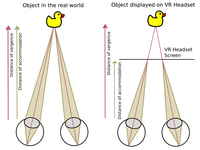Vergence-accommodation conflict

Okay, so when you look at things, your eyes have to do two things at the same time. One thing they have to do is adjust the shape of your lens to be able to see the thing clearly, and that's called accommodation. The other thing they have to do is move inwards or outwards to look at the thing from two slightly different angles, and that's called vergence.
But sometimes those two things get in conflict with each other. When you look at something that's very close to your eyes, like a book or a toy right in front of you, your eyes have to move inwards to see it properly. And at the same time, they also have to adjust the shape of your lens to see it clearly. But when you look at something that's far away, like a bird in the sky or a mountain, your eyes have to move outwards to see it properly, but they also have to adjust the shape of your lens to see it clearly.
So when you look at something that's in between, like a screen or a tablet, your eyes get confused. They don't know whether to adjust the shape of your lens or move inwards or outwards. That's called a vergence-accommodation conflict. And it can make your eyes tired, give you headaches or even make you dizzy. That's why some people wear glasses that help their eyes adjust to different distances, so they don't get that conflict.
But sometimes those two things get in conflict with each other. When you look at something that's very close to your eyes, like a book or a toy right in front of you, your eyes have to move inwards to see it properly. And at the same time, they also have to adjust the shape of your lens to see it clearly. But when you look at something that's far away, like a bird in the sky or a mountain, your eyes have to move outwards to see it properly, but they also have to adjust the shape of your lens to see it clearly.
So when you look at something that's in between, like a screen or a tablet, your eyes get confused. They don't know whether to adjust the shape of your lens or move inwards or outwards. That's called a vergence-accommodation conflict. And it can make your eyes tired, give you headaches or even make you dizzy. That's why some people wear glasses that help their eyes adjust to different distances, so they don't get that conflict.
Related topics others have asked about:
